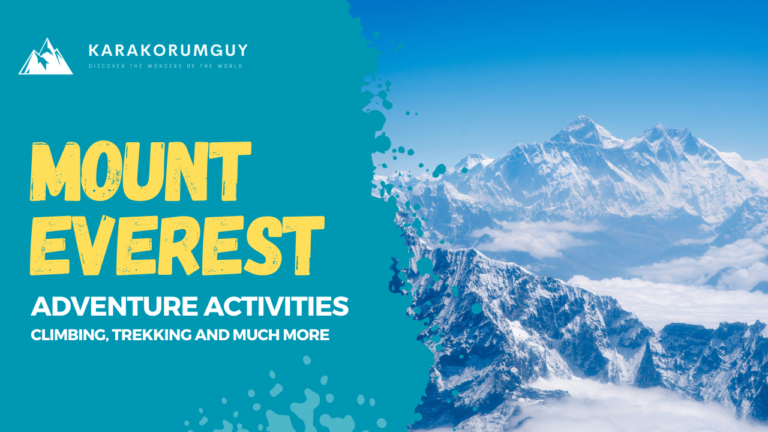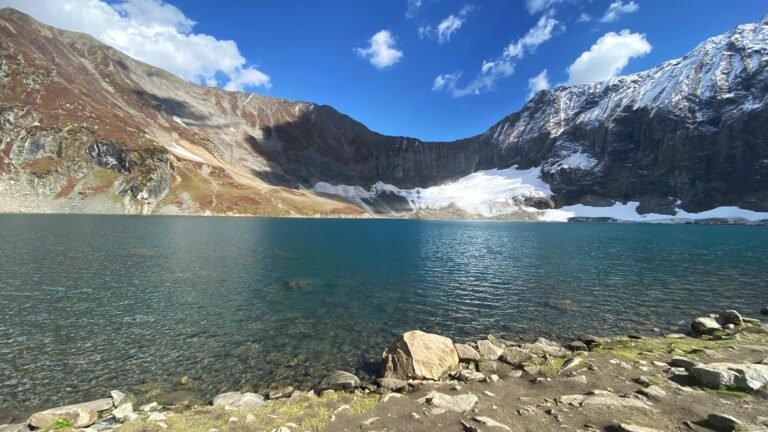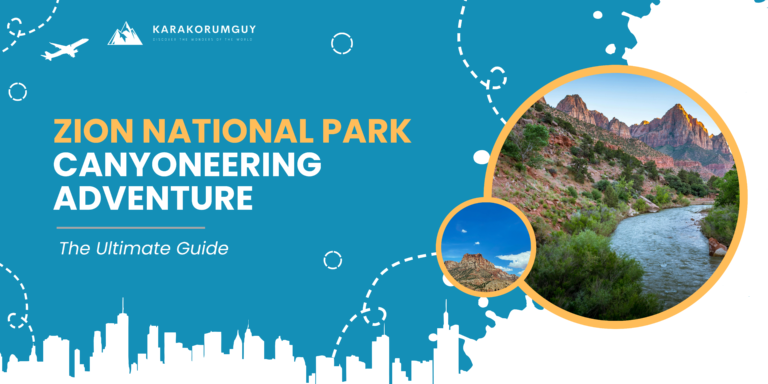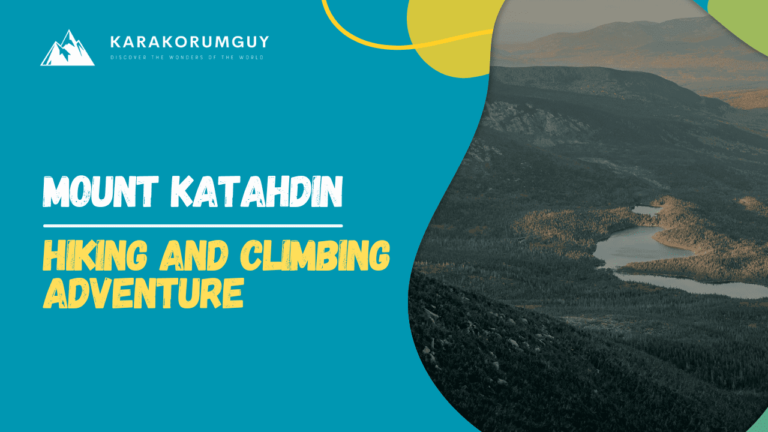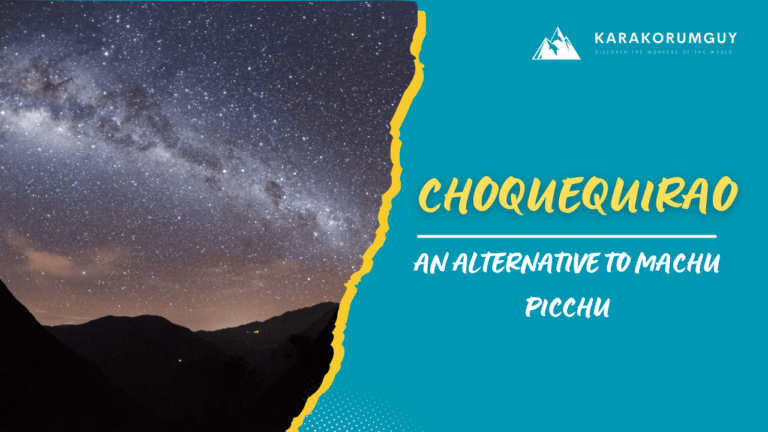K2 Mountain Is The 2nd Highest Mountain in the World

k2 Mountain, also known as Mount Godwin-Austen or Chhogori, is the second-highest mountain in the world, renowned for its breathtaking beauty and formidable challenges. In this comprehensive guide, we’ll delve into every aspect of K2, providing you with a complete understanding of this iconic peak.
So, let’s dive deep into all the fascinating details about this incredible peak.
Height and Location
It stands tall at an awe-inspiring height of 8,611 meters (28,251 feet) above sea level, nestled in the Karakoram Range on the China-Pakistan border. It is situated in the Baltistan region of Pakistan and the Taxkorgan Tajik Autonomous County of Xinjiang, China, K2 dominates the skyline with its pyramid-shaped peak. Its sheer elevation and remote location pose significant challenges to climbers.
Climate and Terrain
The climate and terrain of K2 are characterized by extreme conditions due to its high altitude and rugged landscape. Below are the details of Climate and Terrain of K2:
1. Climate:
It experiences a harsh and unpredictable climate, typical of high-altitude mountain regions. Summers are relatively short and cool, with temperatures occasionally rising above freezing at lower elevations. However, even in summer, temperatures can plummet well below freezing at higher elevations, with strong winds adding to the chill factor. Winters are long, bitterly cold, and marked by heavy snowfall, making climbing extremely challenging.
2. Terrain:
The terrain around K2 is rugged, steep, and unforgiving, consisting of jagged rock faces, icy slopes, and crevassed glaciers. The mountain is notorious for its technical difficulty, with treacherous sections such as the infamous “Bottleneck” and “The Chimney” presenting significant obstacles to climbers. Avalanches, rockfall, and icefall are constant hazards, further adding to the perilous nature of the terrain.
Difficulty Level
K2 Mountain is widely regarded as one of the most difficult mountains to climb in the world. Its steep slopes, unpredictable weather conditions, and technical challenges make it a formidable peak even for experienced climbers. The extreme altitude, reaching 8,611 meters (28,251 feet), adds another layer of difficulty, increasing the risk of altitude sickness and other health hazards. Additionally, the remoteness of the mountain and the lack of infrastructure further contribute to its difficulty level. It is revered by mountaineers as one of the most difficult and dangerous mountains to climb, earning the nickname “Savage Mountain.”
Is K2 more difficult to climb than Mount Everest?
Many experienced climbers consider K2 to be more challenging to climb than Mount Everest. While Everest is the tallest mountain in the world, reaching 8,848 meters (29,029 feet), K2, standing at 8,611 meters (28,251 feet), is often regarded as more technically demanding and dangerous. K2 has steeper ascents, more severe weather conditions, and a higher fatality rate among climbers. The combination of its steep terrain, unpredictable weather, and the technical difficulty of its routes make K2 a formidable challenge for even the most skilled mountaineers.
The Climbing History of K2
It has a storied climbing history marked by triumphs, tragedies, and incredible feats of human endurance. Here’s an overview:
1. Exploration and Early Attempts:
It was first surveyed by British surveyors in the late 19th century. Early attempts to climb it were made by expeditions led by British, Italian, and American climbers, but all failed to reach the summit.
2. First Ascent:
The Italian expedition led by Ardito Desio finally succeeded in reaching the summit on July 31, 1954. Lino Lacedelli and Achille Compagnoni became the first climbers to stand on the peak of K2. However, the expedition was marred by controversy and tragedy, as one of the climbers, Walter Bonatti, was forced to spend a night out in the open at high altitude, sparking a dispute about the team’s tactics.
3. Winter Ascents:
K2 remained unclimbed in winter for many years due to its extreme weather conditions and technical challenges. The first successful winter ascent was achieved by a team of Polish climbers on February 6, 2021. This was a remarkable achievement in the history of mountaineering.
4. Tragedies:
It is infamous for its high fatality rate among climbers. Many expeditions have ended in tragedy, with climbers succumbing to avalanches, falls, and adverse weather conditions. The most deadly day in K2’s climbing history was August 1, 2008, when 11 climbers died in a series of accidents on the mountain.
5. Notable Climbs:
Over the years, K2 has seen numerous notable climbs and attempts, including Reinhold Messner and Hans Kammerlander’s alpine-style ascent in 1979, and the first successful ascent by a woman, Wanda Rutkiewicz of Poland, in 1986.
6. Modern Climbing:
In recent years, It has continued to attract climbers from around the world, drawn by its formidable challenge and status as one of the world’s highest peaks. Despite advances in equipment and techniques, it remains a highly dangerous and unpredictable mountain, with success often dependent on favorable weather conditions and a combination of skill, experience, and luck.
Challenges of Climbing K2
Climbing this miountain presents numerous challenges that make it one of the most difficult mountains to conquer which are as follows:
- Extreme Weather: It is notorious for its harsh and unpredictable weather conditions. Sudden storms, high winds, and extreme cold can strike at any time, posing significant risks to climbers.
- Technical Difficulty: The routes to the summit of K2 are steep and technical, requiring advanced mountaineering skills such as ice climbing, rock climbing, and navigating through treacherous terrain.
- Avalanche Danger: The steep slopes of K2 are prone to avalanches, particularly in the notorious “Bottleneck” area near the summit. Climbers must navigate this hazardous section with caution.
- Altitude: As with any high-altitude climb, K2 presents the risk of altitude sickness, which can be debilitating or even fatal. Acclimatization is crucial, but the extreme altitude still takes a toll on the body.
- Isolation: It is located in a remote and rugged region of the Karakoram Range in Pakistan, far from any easily accessible medical assistance or rescue resources. In the event of an emergency, rescue operations can be challenging and delayed.
- Thin Air: The high altitude near the summit of K2 means that climbers must contend with reduced oxygen levels, making every movement physically demanding and exhausting.
- Rockfall: Loose rock and icefall are common hazards on K2’s steep slopes, posing a constant threat to climbers below.
These challenges, combined with the mountain’s reputation as the “Savage Mountain,” make K2 one of the most daunting and dangerous peaks in the world to climb.
Success Rate Of Climbing
The success rate of climbing K2 varies from year to year and depends on several factors including weather conditions, route difficulty, and the experience level of climbers. Generally, the success rate for reaching the summit of K2 is lower compared to other high peaks like Mount Everest due to its notoriously challenging terrain and unpredictable weather. On average, the success rate for climbing K2 is around 25-30%, making it one of the most difficult and dangerous mountains to ascend.
Fatality Rate: Deadliest Peak
The fatality rate of K2 is notoriously high. It’s considered one of the most challenging peaks to climb in the world, with steep terrain, unpredictable weather, and extreme altitude contributing to its danger. The exact fatality rate can vary from year to year, but historically it has been estimated at around 25%, making it one of the deadliest of the world’s highest mountains.
Disasters of K2
It is notorious for its extreme weather conditions, treacherous terrain, and the technical difficulty of its routes. Over the years, it has seen its fair share of disasters, many of which have resulted in tragic loss of life. Here are some notable ones:
- 1953 American Expedition: This expedition was one of the earliest attempts to summit K2. Tragically, it ended in disaster when a serac (a block or column of glacial ice) collapsed, killing five climbers.
- 1986 K2 Disaster: One of the deadliest incidents on K2 occurred in 1986 when thirteen climbers died within a span of just a few days. Severe weather trapped several teams near the summit, leading to frostbite, exhaustion, and ultimately death.
- 2008 K2 Tragedy: In August 2008, a series of accidents on K2 resulted in the deaths of 11 climbers. Among the incidents was a massive icefall that swept away fixed ropes, leaving climbers stranded high on the mountain without a safe route of descent.
- 2018 Avalanche: In 2018, an avalanche struck K2, claiming the lives of at least one climber and leaving others injured. The avalanche occurred in the notorious Bottleneck area, where climbers are particularly vulnerable to such hazards.
- 2020 Fatal Fall: A Russian mountaineer fell to his death while attempting to descend from the summit of K2. His fall underscores the inherent dangers of climbing this formidable peak, even during descent when climbers are often fatigued and conditions are unpredictable.
Attractions of K2 for Tourists
K2 exerts a magnetic pull on adventurers and tourists alike. Here’s what draws them in:
- Iconic Status: Its reputation as the “Savage Mountain” intrigues climbers and outdoor enthusiasts. Its towering presence and challenging ascent make it a coveted destination for those seeking the ultimate mountaineering challenge.
- Natural Beauty: Nestled in the Karakoram Range on the border between Pakistan and China, K2 offers breathtaking vistas of jagged peaks, glaciers, and pristine landscapes. The sheer beauty of the surroundings is a major draw for nature lovers and photographers.
- Cultural Richness: Surrounding regions like the Baltistan area of Pakistan are culturally rich, offering tourists a glimpse into the unique traditions, cuisine, and lifestyle of the local communities. The diversity of cultures adds depth to the K2 experience.

Adventure Activities:
1. Mountaineering:
Ascending K2 is the pinnacle of mountaineering challenges. The arduous journey to the summit involves technical climbing, navigating treacherous terrain, and enduring extreme weather conditions. Only the most skilled and experienced climbers attempt this feat.
2. Trekking:
For those not ready to tackle the summit, trekking in the K2 region offers a more accessible adventure. Popular treks like the K2 Base Camp trek provide stunning views of the mountain and surrounding peaks, along with opportunities to experience the local culture and hospitality.
3. Glacier Exploration:
Glaciers abound in the K2 region, offering adventurers the chance to explore these frozen landscapes. Glacier trekking and ice climbing are popular activities for those seeking a more hands-on experience with the mountain’s icy terrain.
4. Photography:
The dramatic landscapes and ever-changing light conditions make K2 and its surroundings a paradise for photographers. From sunrise over the Karakoram to the play of light on glaciers, there’s no shortage of stunning scenes to capture.
5. Cultural Immersion:
Exploring the villages and communities around K2 allows tourists to immerse themselves in the local culture. Visitors can interact with villagers, sample traditional cuisine, and learn about the customs and traditions that have shaped life in the region for centuries.
Climbing Opportunities
For people who want to climb K2, it’s important to be careful and ready because it’s really hard and the weather can change suddenly. Here are some ways to climb K2:
1. Organized Expeditions:
Joining an organized expedition led by experienced guides and outfitters is a popular choice for many climbers. These expeditions provide essential logistical support, including permits, equipment, and seasoned staff to navigate the complexities of K2’s terrain and weather.
2. Independent Climbing:
For highly experienced climbers with a robust background in high-altitude mountaineering, the option of an independent climb exists. However, this route requires meticulous planning and preparation, including obtaining permits, arranging transportation, accommodation, and supplies.
Climbing Routes of K2
It is renowned for its challenging climbing routes and extreme weather conditions. Here’s an overview of the main routes to the summit, along with their highlights and difficulty levels:
1. Abruzzi Spur Route:
- Overview: The Abruzzi Spur, also known as the Southeast Ridge, is the most popular and frequently climbed route on K2. It follows the southeast ridge of the mountain, offering stunning views and relatively stable terrain.
- Highlights: The Bottleneck, a narrow couloir just below the summit, is a notorious feature of this route. Climbers must navigate steep ice and rock sections, often with fixed ropes, making it a challenging and technical ascent.
- Difficulty Level: Considered one of the more technically difficult routes on K2, requiring advanced mountaineering skills and experience in high-altitude climbing.
2. Cesen Route:
- Overview: The Cesen Route, also known as the Southwest Pillar, follows a direct line up the southwest face of K2. It offers a more direct and challenging ascent compared to the Abruzzi Spur.
- Highlights: The House’s Chimney, a prominent feature on the route, presents climbers with a series of steep rock and ice pitches. The route also offers spectacular views of the surrounding Karakoram Range.
- Difficulty Level: Considered extremely challenging, with technical climbing sections and significant objective hazards such as rockfall and avalanches.
3. Magic Line:
- Overview: The Magic Line is a relatively new route on K2, first successfully climbed in 2018 by a team of Russian mountaineers. It follows a line between the Abruzzi Spur and the Cesen Route, offering a more direct and technically demanding variation.
- Highlights: The route features steep and exposed sections, including the “Black Pyramid” near the summit, which requires careful navigation and skillful climbing.
- Difficulty Level: Extremely challenging, with a high level of technical difficulty and objective hazards. Only experienced and skilled climbers attempt this route.
5. North Ridge Route:
- Overview: The North Ridge of K2 offers a less-traveled but equally challenging route to the summit. It follows the ridge separating the Chinese side of the mountain from the Baltoro Glacier.
- Highlights: The route offers stunning views of the Chinese side of the mountain and the vast expanse of the Tibetan Plateau. However, it is characterized by technical climbing, icy terrain, and unpredictable weather.
- Difficulty Level: Considered one of the most technically challenging routes on K2, with steep rock and ice sections and objective hazards such as avalanches and crevasse falls.
Each of these routes presents its own set of challenges and rewards, attracting experienced climbers from around the world seeking the ultimate test of skill and endurance.
Trekking Through the Karakoram: Exploring the Beauty of K2
Trekking on K2 is a captivating journey through rugged landscapes, offering a glimpse into the raw beauty of one of the world’s most iconic peaks. The trek to K2 base camp is immersive, leading through remote valleys, ancient glaciers, and dramatic passes. Trekkers enjoy breathtaking vistas of towering peaks, sparkling lakes, and alpine meadows. Colorful villages along the trail offer cultural immersion. Each step brings closer to K2’s foot, leaving an indelible mark. K2 trekking is a rare opportunity to connect with nature and witness Karakoram’s unparalleled beauty.
Popular Trekking Routes
This peak is a dream destination for many trekkers and mountaineers. While the trekking routes to K2 Base Camp vary in difficulty, they all offer stunning views of the Karakoram Range and an unforgettable adventure. Here are some popular trekking routes to K2 Base Camp along with route details, descriptions, and difficulty levels:
1. Classic K2 Base Camp Trek via Baltoro Glacier:
- Route Details: The trek starts from Skardu in Pakistan’s Gilgit-Baltistan region. Trekkers follow the Baltoro Glacier, passing iconic peaks like Broad Peak and Gasherbrum IV before reaching Concordia, the meeting point of Baltoro and Godwin-Austen glaciers. From Concordia, the trail continues to K2 Base Camp.
- Description: This trek offers unparalleled views of K2 and other majestic peaks. Trekkers traverse rugged terrain, cross glacier moraines, and negotiate high passes. The journey to Concordia involves long trekking days and camping in remote areas.
- Difficulty Level: Strenuous. The altitude, challenging terrain, and variable weather conditions make this trek suitable for experienced trekkers with good physical fitness.
2. Gondogoro La Trek:
- Route Details: This trek starts from Askole village and follows the same route as the Classic K2 Base Camp Trek until Concordia. From Concordia, trekkers ascend the Gondogoro La Pass (5,940 meters) and descend into the Hushe Valley.
- Description: The highlight of this trek is crossing the Gondogoro La Pass, offering breathtaking panoramic views of K2, Broad Peak, and the surrounding peaks. The descent into the Hushe Valley rewards trekkers with lush green landscapes and remote villages.
- Difficulty Level: Challenging. Crossing the high-altitude pass involves steep ascents, technical sections, and potential weather challenges. Trekkers need prior high-altitude trekking experience and good acclimatization.
3. K2 Base Camp Trek via the Abruzzi Spur:
- Route Details: This route starts from the village of Askole and follows the Baltoro Glacier. Unlike the Classic route, trekkers branch off towards the Abruzzi Spur, the most popular route for K2 climbers, to reach K2 Base Camp.
- Description: Trekkers get close-up views of the legendary K2 Base Camp and the route taken by mountaineers attempting to summit K2. The terrain is rugged, with rocky moraines and occasional crevasses.
- Difficulty Level: Moderate to Strenuous. While the trekking terrain is not as technically challenging as Gondogoro La, it still involves long days of trekking at high altitudes. Some sections may require scrambling over rocky terrain.
These are just a few of the popular trekking routes to K2 Base Camp, each offering a unique experience and adventure in the heart of the Karakoram Range. Trekkers should always be well-prepared, physically fit, and equipped with proper gear for the challenging conditions encountered in this remote and pristine wilderness.
Best Time To Visit
The best time to visit for climbing and trekking is during the summer months, from June to August. During this time, the weather on the mountain tends to be more stable, with fewer chances of extreme cold and heavy snowfall. The days are longer, providing more daylight for climbing and trekking activities. However, even during the summer, the weather on K2 can be unpredictable, and climbers and trekkers should always be prepared for sudden changes and adverse conditions. Additionally, it’s essential to check with local authorities and experienced guides for the most up-to-date information on weather conditions and safety considerations before planning a trip to K2.
Essential Gear List for Trekking and Climbing K2
Trekking and climbing require careful preparation and a comprehensive gear list to ensure safety and success in the challenging conditions. Here’s an essential gear list for tackling K2:
- Mountaineering Boots
- Crampons
- Ice Axe
- Harness and Climbing Rope
- Helmet
- Trekking Poles
- Clothing Layers (base, mid, outer)
- Down Jacket
- Sleeping Bag
- Tent
- Cooking Equipment (stove, fuel, utensils)
- Food and Water (high-energy, lightweight, water purification)
- Navigation Tools (map, compass, GPS)
- First Aid Kit
- Headlamp
- Sunglasses and Sunscreen
- Gloves and Hat
- Altitude Gear (oxygen, medication)
- Communication Devices (satellite phone, radio)
- Emergency Shelter
- Personal Items (toiletries, repair kits, medications)
It’s crucial to select high-quality gear, test it beforehand in similar conditions, and ensure proper training and acclimatization before attempting to trek or climb K2. Additionally, consulting with experienced mountaineers or hiring a certified guide service can enhance safety and preparedness for the expedition.
Safety Precautions for Climbing and Trekking K2
Climbing and trekking this mountain require serious safety precautions due to its extreme altitude, unpredictable weather, and challenging terrain. Here are some essential safety measures:
1. Acclimatization:
Gradually ascend to higher altitudes to allow your body to adjust to the reduced oxygen levels. Spend several days at different base camps to acclimatize properly.
2. Proper Gear:
Invest in high-quality gear suitable for extreme conditions, including insulated clothing, mountaineering boots, crampons, ice axes, helmets, and a sturdy tent. Ensure all equipment is in good condition and tested before the expedition.
3. Experienced Guide:
Hire an experienced and certified guide familiar with K2’s terrain and weather patterns. A knowledgeable guide can provide invaluable advice, navigate difficult sections, and assist in emergencies.
4. Weather monitoring:
Keep a close eye on weather forecasts before and during the climb. K2 is notorious for sudden and severe weather changes, including blizzards and high winds. Be prepared to adjust plans accordingly and retreat to lower altitudes if necessary.
5. Hydration and Nutrition:
Stay properly hydrated and nourished throughout the expedition. Bring sufficient water and high-energy snacks to maintain strength and endurance. Avoid alcohol and caffeine, as they can contribute to dehydration.
6. Emergency Communication:
Carry a satellite phone, radio, or personal locator beacon (PLB) for emergency communication. Ensure all team members know how to use these devices and have a designated emergency plan in place.
7. Rope Safety:
Use ropes and harnesses when navigating steep or icy sections of the route. Practice proper rope techniques, including belaying and rappelling, and always double-check knots and anchors.
8. Altitude Sickness Prevention:
Monitor yourself and team members for symptoms of altitude sickness, such as headaches, nausea, and dizziness. Descend immediately if symptoms worsen and seek medical attention if necessary.
9. Avalanche Awareness:
Be aware of avalanche-prone areas and avoid traveling through them when conditions are unstable. Carry avalanche safety gear, including probes, shovels, and avalanche transceivers, and practice rescue techniques beforehand.
10. Team Communication:
Maintain open and clear communication with your climbing team at all times. Establish signals and protocols for decision-making, route finding, and emergencies.
11. Leave No Trace:
Respect the natural environment by following Leave No Trace principles. Pack out all waste, minimize disturbance to wildlife, and avoid damaging vegetation.
12. Physical Fitness:
Prepare adequately with a comprehensive training regimen focused on cardiovascular endurance, strength training, and flexibility. Being physically fit can enhance performance and reduce the risk of injury.
Remember that climbing K2 is an inherently risky endeavor, and even with proper precautions, accidents can still occur. Prioritize safety above all else, and be prepared to make conservative decisions for the well-being of yourself and your team.
Are there any Rescue Services on K2?
There are rescue services available on K2, one of the world’s highest and most challenging mountains. However, due to its extreme altitude, unpredictable weather, and treacherous terrain, rescue operations on K2 are extremely difficult and dangerous. Various organizations and teams, including local and international mountaineering associations, as well as government agencies, may coordinate rescue efforts when needed. These rescue teams often consist of highly skilled climbers and mountaineers who risk their lives to save others in distress on the mountain.
Sustainable Tourism and Conservation Efforts in the K2 Region
As the popularity of K2 trekking and climbing continues to grow, the need for sustainable tourism practices and conservation efforts becomes increasingly pressing. Local communities play a vital role in preserving the natural beauty and cultural heritage of the region, promoting responsible tourism initiatives that benefit both visitors and residents alike. Conservation organizations work tirelessly to protect the fragile ecosystem of the Karakoram Range, implementing measures to minimize environmental impact and promote biodiversity conservation.
Accommodations Options on K2
For accommodation options on K2, you’ll primarily find options in nearby towns and villages rather than directly at the base of the mountain due to its remote and rugged terrain. Here are some options:
1. Base Camp Tents:
- Most climbers and trekkers opt to stay in tents at various base camps along K2’s routes.
- These camps are established by expedition teams and offer basic facilities such as shelter, food, and medical assistance.
2. Nearby Villages or Towns:
Basic lodging options may be available in nearby villages or towns. However, these accommodations often require a trek or journey from the mountain itself. Here are some options:
- Skardu: This is one of the main hubs for trekkers and mountaineers heading to K2. You’ll find a range of accommodations here including hotels, guesthouses, and campsites.
- Askole: This is the last village before the trek to K2 Base Camp begins. You might find some basic guesthouses or camping options here.
- Concordia: This is a popular camping site en route to K2 Base Camp. You can camp here or find accommodation in temporary tent camps set up during the trekking season.
- Gilgit: Another major town in the region, Gilgit offers various accommodation options ranging from budget guesthouses to mid-range hotels.
- Baltoro Glacier: Along the trekking route, there are some temporary campsites and basic lodges catering to trekkers and climbers.
- Hushe: This is another village commonly used as a starting point for treks to K2 Base Camp. Accommodation options may be limited but you can find basic guesthouses.
Note: It’s important to note that facilities can be basic and accommodations may fill up quickly during the peak trekking season. It’s advisable to book in advance, especially if you’re planning a trek to K2.
Transportation Guide to Reach K2
To reach K2, the second highest mountain in the world, you’ll need to plan your transportation carefully. Here’s a guide:
1. International Travel:
- If you’re coming from abroad, you’ll likely need to fly into Pakistan or China, as K2 is situated on the border of these two countries.
- Islamabad, the capital city of Pakistan, and Urumqi, a major city in China’s Xinjiang region, are common entry points for travelers aiming to reach K2.
2. Domestic Travel (Pakistan):
- If you’re flying into Islamabad, you can then take a domestic flight to Skardu, a city in the Gilgit-Baltistan region of Pakistan. Skardu serves as a base for many expeditions to K2.
- Alternatively, you can opt for a scenic drive from Islamabad to Skardu, though it’s a long journey of approximately 22 hours by road.
3. Trekking or Helicopter Ride:
- From Skardu, you have the option to trek to K2 Base Camp. This trek typically takes around 8-10 days, depending on your pace and the weather conditions.
- For a faster but more expensive option, you can arrange a helicopter ride from Skardu to Concordia, a large glacial junction near K2 Base Camp.
4. Travel Restrictions and Permits:
- Keep in mind that traveling to K2 requires permits from the local authorities in Pakistan. Ensure you have obtained all necessary permits before embarking on your journey.
- Additionally, check for any travel advisories or restrictions in the region, as political and weather-related factors can impact your plans.
5. Mountaineering Expeditions:
- If you’re planning to climb K2, you’ll need to join a mountaineering expedition. These expeditions typically require extensive planning, training, and coordination with experienced guides and support teams.
6. Safety Precautions:
- K2 is a challenging and dangerous mountain to climb, with a high risk of avalanches, extreme weather, and altitude sickness. Ensure you’re adequately prepared with proper gear, training, and medical supplies.
7. Environmental Considerations:
- Respect the fragile ecosystem of the region by adhering to Leave No Trace principles and following local regulations regarding waste disposal and conservation.
Remember to plan your trip well in advance, considering factors such as weather conditions, transportation availability, and your own physical preparedness. K2 is a majestic but formidable peak, and reaching its base or summit requires careful preparation and determination.
Other Attractions Near K2
The primary attraction is undoubtedly the majestic peak itself but there are several nearby attractions that visitors may find fascinating, which are listed below:
- Concordia: Often referred to as the “throne room of the mountain gods,” Concordia is a stunning glacial junction where the Baltoro Glacier meets the Godwin-Austen Glacier. It offers breathtaking views of several of the world’s highest peaks, including K2, Broad Peak, Gasherbrum I, and Gasherbrum II.
- Baltoro Glacier: This is one of the longest glaciers outside the polar regions and serves as the access route to K2 and other peaks in the region. The glacier’s immense size and rugged beauty make it a popular trekking destination.
- Gasherbrum Massif: Located to the south of K2, the Gasherbrum Massif is home to several of the world’s highest peaks, including Gasherbrum I (Hidden Peak) and Gasherbrum II. These peaks offer challenging climbs for experienced mountaineers.
- Karakoram Highway: Known as the Eighth Wonder of the World, the Karakoram Highway is one of the highest paved roads on the planet. It offers stunning views of the Karakoram Range and connects Pakistan to China via the Khunjerab Pass.
- Hunza Valley: While not directly adjacent to K2, the Hunza Valley is a beautiful destination that can be visited before or after a trip to K2 base camp. It’s famous for its breathtaking scenery, terraced fields, and traditional culture.
- Skardu: The gateway to the Karakoram Range, Skardu is a picturesque town situated along the Indus River. It offers opportunities for trekking, mountaineering, and exploring the rich Balti culture.
These attractions provide visitors with a diverse range of experiences, from high-altitude trekking and mountaineering to cultural immersion and scenic drives.
Conclusion
In this comprehensive guide, we’ve explored every aspect of K2, from its towering height of 8,611 meters (28,251 feet) to its treacherous terrain and challenging climbing routes. Situated in the Karakoram Range on the China-Pakistan border, K2 is renowned for its extreme weather conditions, low summit success rate, and high fatality rate, earning it the moniker “Savage Mountain.” Despite its dangers, K2 continues to attract climbers and trekkers from around the world, drawn by its breathtaking beauty and the allure of conquering one of the world’s highest peaks. From the history of climbing attempts to safety precautions and popular trekking routes, this guide provides valuable insights for anyone interested in experiencing the majesty and challenges of K2.
Hope you found the article enjoyable to read. If you want to read more then check our other blogs on World’s Top 10 Mountain Peaks.


